Wei Han
Britton Chance Center for Biomedical Photonics, Wuhan National Laboratory for Optoelectronics-Huazhong University of Science and Technology, China
Language-Guided Graph Representation Learning for Video Summarization
Nov 14, 2025Abstract:With the rapid growth of video content on social media, video summarization has become a crucial task in multimedia processing. However, existing methods face challenges in capturing global dependencies in video content and accommodating multimodal user customization. Moreover, temporal proximity between video frames does not always correspond to semantic proximity. To tackle these challenges, we propose a novel Language-guided Graph Representation Learning Network (LGRLN) for video summarization. Specifically, we introduce a video graph generator that converts video frames into a structured graph to preserve temporal order and contextual dependencies. By constructing forward, backward and undirected graphs, the video graph generator effectively preserves the sequentiality and contextual relationships of video content. We designed an intra-graph relational reasoning module with a dual-threshold graph convolution mechanism, which distinguishes semantically relevant frames from irrelevant ones between nodes. Additionally, our proposed language-guided cross-modal embedding module generates video summaries with specific textual descriptions. We model the summary generation output as a mixture of Bernoulli distribution and solve it with the EM algorithm. Experimental results show that our method outperforms existing approaches across multiple benchmarks. Moreover, we proposed LGRLN reduces inference time and model parameters by 87.8% and 91.7%, respectively. Our codes and pre-trained models are available at https://github.com/liwrui/LGRLN.
Nowcast3D: Reliable precipitation nowcasting via gray-box learning
Nov 06, 2025Abstract:Extreme precipitation nowcasting demands high spatiotemporal fidelity and extended lead times, yet existing approaches remain limited. Numerical Weather Prediction (NWP) and its deep-learning emulations are too slow and coarse for rapidly evolving convection, while extrapolation and purely data-driven models suffer from error accumulation and excessive smoothing. Hybrid 2D radar-based methods discard crucial vertical information, preventing accurate reconstruction of height-dependent dynamics. We introduce a gray-box, fully three-dimensional nowcasting framework that directly processes volumetric radar reflectivity and couples physically constrained neural operators with datadriven learning. The model learns vertically varying 3D advection fields under a conservative advection operator, parameterizes spatially varying diffusion, and introduces a Brownian-motion--inspired stochastic term to represent unresolved motions. A residual branch captures small-scale convective initiation and microphysical variability, while a diffusion-based stochastic module estimates uncertainty. The framework achieves more accurate forecasts up to three-hour lead time across precipitation regimes and ranked first in 57\% of cases in a blind evaluation by 160 meteorologists. By restoring full 3D dynamics with physical consistency, it offers a scalable and robust pathway for skillful and reliable nowcasting of extreme precipitation.
Doc-Researcher: A Unified System for Multimodal Document Parsing and Deep Research
Oct 24, 2025Abstract:Deep Research systems have revolutionized how LLMs solve complex questions through iterative reasoning and evidence gathering. However, current systems remain fundamentally constrained to textual web data, overlooking the vast knowledge embedded in multimodal documents Processing such documents demands sophisticated parsing to preserve visual semantics (figures, tables, charts, and equations), intelligent chunking to maintain structural coherence, and adaptive retrieval across modalities, which are capabilities absent in existing systems. In response, we present Doc-Researcher, a unified system that bridges this gap through three integrated components: (i) deep multimodal parsing that preserves layout structure and visual semantics while creating multi-granular representations from chunk to document level, (ii) systematic retrieval architecture supporting text-only, vision-only, and hybrid paradigms with dynamic granularity selection, and (iii) iterative multi-agent workflows that decompose complex queries, progressively accumulate evidence, and synthesize comprehensive answers across documents and modalities. To enable rigorous evaluation, we introduce M4DocBench, the first benchmark for Multi-modal, Multi-hop, Multi-document, and Multi-turn deep research. Featuring 158 expert-annotated questions with complete evidence chains across 304 documents, M4DocBench tests capabilities that existing benchmarks cannot assess. Experiments demonstrate that Doc-Researcher achieves 50.6% accuracy, 3.4xbetter than state-of-the-art baselines, validating that effective document research requires not just better retrieval, but fundamentally deep parsing that preserve multimodal integrity and support iterative research. Our work establishes a new paradigm for conducting deep research on multimodal document collections.
FT-MDT: Extracting Decision Trees from Medical Texts via a Novel Low-rank Adaptation Method
Oct 06, 2025Abstract:Knowledge of the medical decision process, which can be modeled as medical decision trees (MDTs), is critical to building clinical decision support systems. However, current MDT construction methods rely heavily on time-consuming and laborious manual annotation. To address this challenge, we propose PI-LoRA (Path-Integrated LoRA), a novel low-rank adaptation method for automatically extracting MDTs from clinical guidelines and textbooks. We integrate gradient path information to capture synergistic effects between different modules, enabling more effective and reliable rank allocation. This framework ensures that the most critical modules receive appropriate rank allocations while less important ones are pruned, resulting in a more efficient and accurate model for extracting medical decision trees from clinical texts. Extensive experiments on medical guideline datasets demonstrate that our PI-LoRA method significantly outperforms existing parameter-efficient fine-tuning approaches for the Text2MDT task, achieving better accuracy with substantially reduced model complexity. The proposed method achieves state-of-the-art results while maintaining a lightweight architecture, making it particularly suitable for clinical decision support systems where computational resources may be limited.
NeuralDB: Scaling Knowledge Editing in LLMs to 100,000 Facts with Neural KV Database
Jul 24, 2025
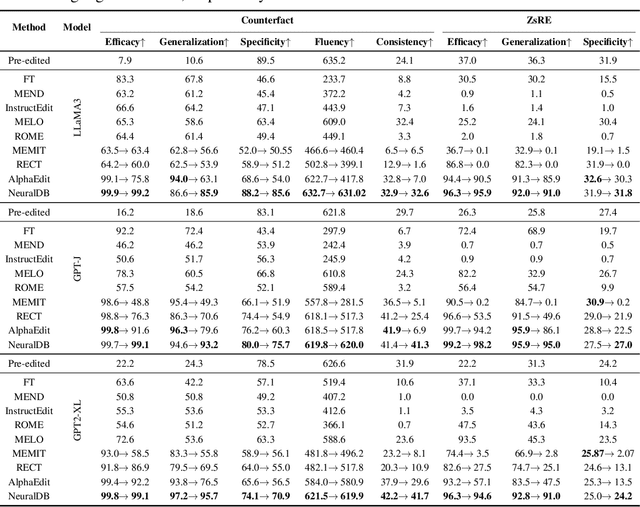
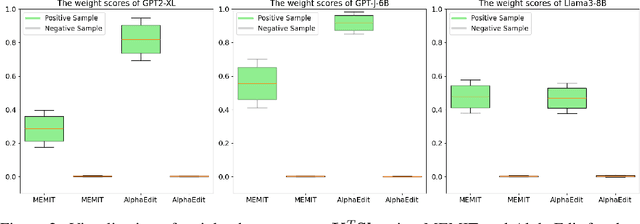

Abstract:Efficiently editing knowledge stored in large language models (LLMs) enables model updates without large-scale training. One possible solution is Locate-and-Edit (L\&E), allowing simultaneous modifications of a massive number of facts. However, such editing may compromise the general abilities of LLMs and even result in forgetting edited facts when scaling up to thousands of edits. In this paper, we model existing linear L\&E methods as querying a Key-Value (KV) database. From this perspective, we then propose NeuralDB, an editing framework that explicitly represents the edited facts as a neural KV database equipped with a non-linear gated retrieval module, % In particular, our gated module only operates when inference involves the edited facts, effectively preserving the general abilities of LLMs. Comprehensive experiments involving the editing of 10,000 facts were conducted on the ZsRE and CounterFacts datasets, using GPT2-XL, GPT-J (6B) and Llama-3 (8B). The results demonstrate that NeuralDB not only excels in editing efficacy, generalization, specificity, fluency, and consistency, but also preserves overall performance across six representative text understanding and generation tasks. Further experiments indicate that NeuralDB maintains its effectiveness even when scaled to 100,000 facts (\textbf{50x} more than in prior work).
MLR-Bench: Evaluating AI Agents on Open-Ended Machine Learning Research
May 26, 2025Abstract:Recent advancements in AI agents have demonstrated their growing potential to drive and support scientific discovery. In this work, we introduce MLR-Bench, a comprehensive benchmark for evaluating AI agents on open-ended machine learning research. MLR-Bench includes three key components: (1) 201 research tasks sourced from NeurIPS, ICLR, and ICML workshops covering diverse ML topics; (2) MLR-Judge, an automated evaluation framework combining LLM-based reviewers with carefully designed review rubrics to assess research quality; and (3) MLR-Agent, a modular agent scaffold capable of completing research tasks through four stages: idea generation, proposal formulation, experimentation, and paper writing. Our framework supports both stepwise assessment across these distinct research stages, and end-to-end evaluation of the final research paper. We then use MLR-Bench to evaluate six frontier LLMs and an advanced coding agent, finding that while LLMs are effective at generating coherent ideas and well-structured papers, current coding agents frequently (e.g., in 80% of the cases) produce fabricated or invalidated experimental results--posing a major barrier to scientific reliability. We validate MLR-Judge through human evaluation, showing high agreement with expert reviewers, supporting its potential as a scalable tool for research evaluation. We open-source MLR-Bench to help the community benchmark, diagnose, and improve AI research agents toward trustworthy and transparent scientific discovery.
Uncertainty-Aware Safety-Critical Decision and Control for Autonomous Vehicles at Unsignalized Intersections
May 26, 2025Abstract:Reinforcement learning (RL) has demonstrated potential in autonomous driving (AD) decision tasks. However, applying RL to urban AD, particularly in intersection scenarios, still faces significant challenges. The lack of safety constraints makes RL vulnerable to risks. Additionally, cognitive limitations and environmental randomness can lead to unreliable decisions in safety-critical scenarios. Therefore, it is essential to quantify confidence in RL decisions to improve safety. This paper proposes an Uncertainty-aware Safety-Critical Decision and Control (USDC) framework, which generates a risk-averse policy by constructing a risk-aware ensemble distributional RL, while estimating uncertainty to quantify the policy's reliability. Subsequently, a high-order control barrier function (HOCBF) is employed as a safety filter to minimize intervention policy while dynamically enhancing constraints based on uncertainty. The ensemble critics evaluate both HOCBF and RL policies, embedding uncertainty to achieve dynamic switching between safe and flexible strategies, thereby balancing safety and efficiency. Simulation tests on unsignalized intersections in multiple tasks indicate that USDC can improve safety while maintaining traffic efficiency compared to baselines.
PREMISE: Matching-based Prediction for Accurate Review Recommendation
May 02, 2025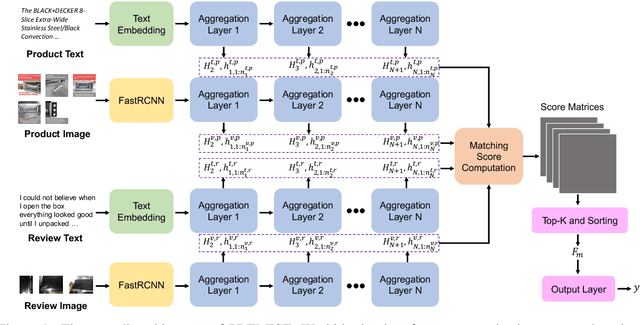
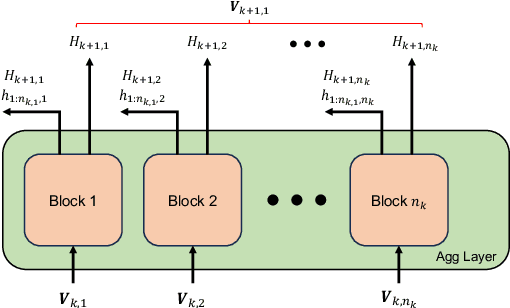


Abstract:We present PREMISE (PREdict with Matching ScorEs), a new architecture for the matching-based learning in the multimodal fields for the multimodal review helpfulness (MRHP) task. Distinct to previous fusion-based methods which obtains multimodal representations via cross-modal attention for downstream tasks, PREMISE computes the multi-scale and multi-field representations, filters duplicated semantics, and then obtained a set of matching scores as feature vectors for the downstream recommendation task. This new architecture significantly boosts the performance for such multimodal tasks whose context matching content are highly correlated to the targets of that task, compared to the state-of-the-art fusion-based methods. Experimental results on two publicly available datasets show that PREMISE achieves promising performance with less computational cost.
APSeg: Auto-Prompt Model with Acquired and Injected Knowledge for Nuclear Instance Segmentation and Classification
Apr 03, 2025
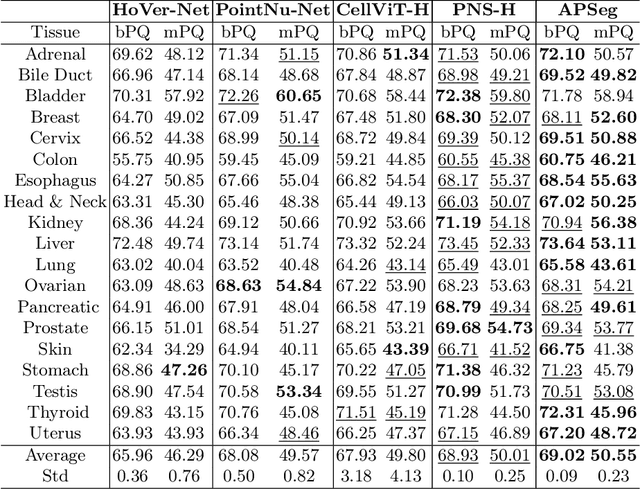


Abstract:Nuclear instance segmentation and classification provide critical quantitative foundations for digital pathology diagnosis. With the advent of the foundational Segment Anything Model (SAM), the accuracy and efficiency of nuclear segmentation have improved significantly. However, SAM imposes a strong reliance on precise prompts, and its class-agnostic design renders its classification results entirely dependent on the provided prompts. Therefore, we focus on generating prompts with more accurate localization and classification and propose \textbf{APSeg}, \textbf{A}uto-\textbf{P}rompt model with acquired and injected knowledge for nuclear instance \textbf{Seg}mentation and classification. APSeg incorporates two knowledge-aware modules: (1) Distribution-Guided Proposal Offset Module (\textbf{DG-POM}), which learns distribution knowledge through density map guided, and (2) Category Knowledge Semantic Injection Module (\textbf{CK-SIM}), which injects morphological knowledge derived from category descriptions. We conducted extensive experiments on the PanNuke and CoNSeP datasets, demonstrating the effectiveness of our approach. The code will be released upon acceptance.
A Survey of Reinforcement Learning-Based Motion Planning for Autonomous Driving: Lessons Learned from a Driving Task Perspective
Mar 31, 2025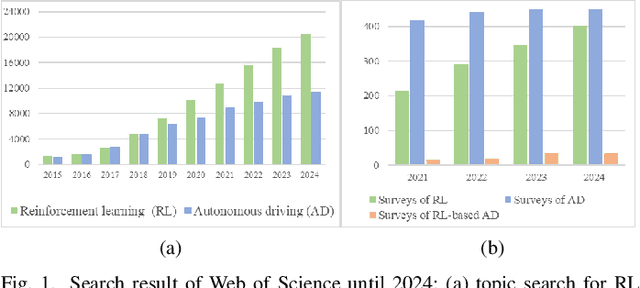
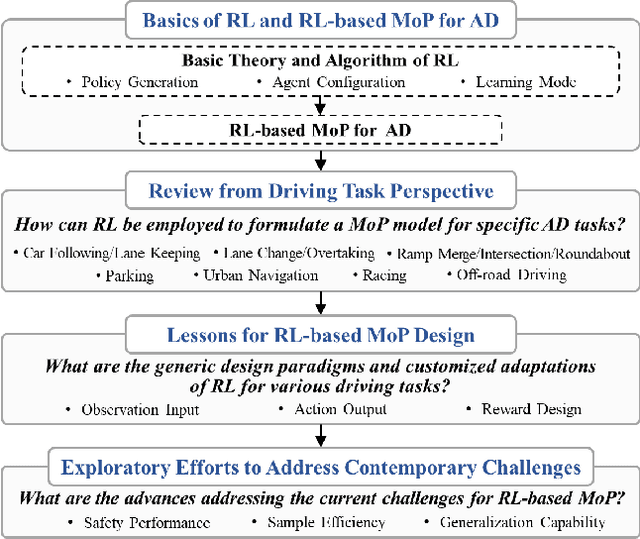
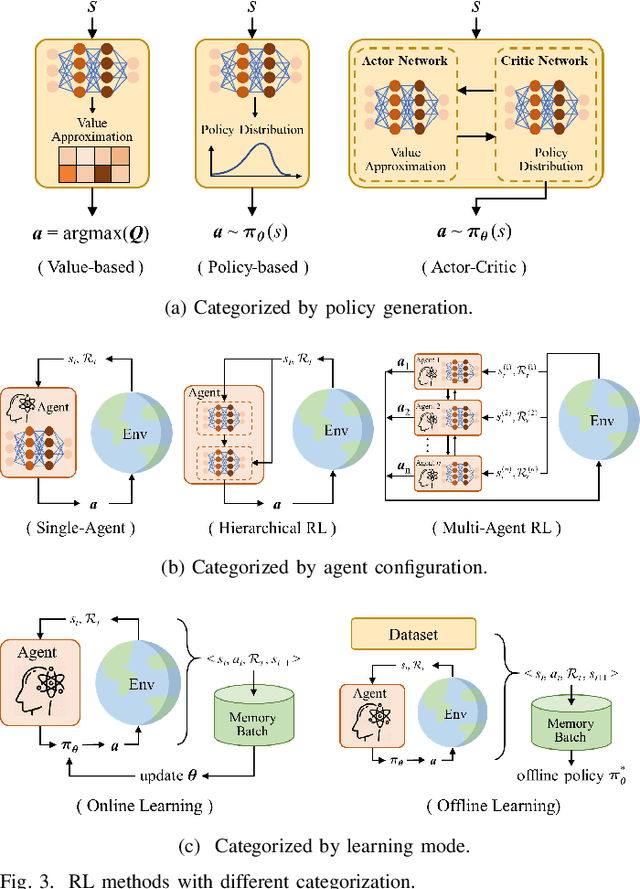
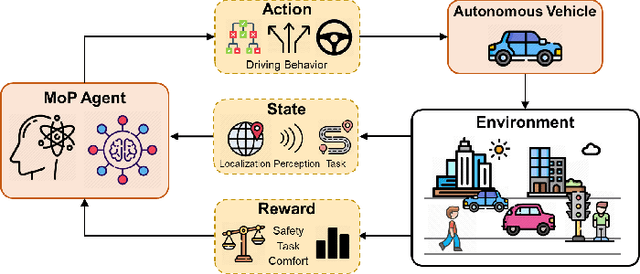
Abstract:Reinforcement learning (RL), with its ability to explore and optimize policies in complex, dynamic decision-making tasks, has emerged as a promising approach to addressing motion planning (MoP) challenges in autonomous driving (AD). Despite rapid advancements in RL and AD, a systematic description and interpretation of the RL design process tailored to diverse driving tasks remains underdeveloped. This survey provides a comprehensive review of RL-based MoP for AD, focusing on lessons from task-specific perspectives. We first outline the fundamentals of RL methodologies, and then survey their applications in MoP, analyzing scenario-specific features and task requirements to shed light on their influence on RL design choices. Building on this analysis, we summarize key design experiences, extract insights from various driving task applications, and provide guidance for future implementations. Additionally, we examine the frontier challenges in RL-based MoP, review recent efforts to addresse these challenges, and propose strategies for overcoming unresolved issues.
 Add to Chrome
Add to Chrome Add to Firefox
Add to Firefox Add to Edge
Add to Edge